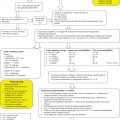Chapter 31
Prevention of Food Allergy
Kate Grimshaw
Introduction
Allergic diseases, such as asthma, rhinitis, eczema and food allergies, are increasing worldwide [1–4] and the increasing prevalence of allergic disease is becoming a major public health concern, particularly in urbanised countries [5]. In the UK, allergic disease accounts for 6% of general practice consultations and 10% of the prescribing budget [6]. Add to this the impact allergic disease has on quality of life of both sufferers and carers [7–9] and that there is currently no cure, it is natural that attention turns to possible prevention strategies.
It is evident that allergic disorders change and progress from eczema and food allergy in infancy and early childhood to asthma, rhinitis and inhalant allergy in older childhood, adolescence and adulthood. This is referred to as the ‘allergic march’ [10]. Food allergy, let alone other manifestations of allergy, has significant individual, household and societal costs [11, 12].
Prevention of the first stage of the allergic march where the body reacts to a food protein after being exposed to it for the first time (known as allergic sensitisation) is the obvious course of action when trying to reduce the prevalence of all allergic disease. The infant’s immune system which first comes into contact with food allergens in utero [13] continues to be exposed after birth via breast milk [14], and then again when solids are introduced into the diet. It is unclear which, if not all, of these exposure time points are important in initiating the allergic march. This is why prevention strategies tend to focus on pregnancy and the first year of life [15].
It is reported that infants born to families with a history of atopy are more at risk of developing allergic diseases than those born to non-atopic families [16], with genetic influences definitely playing a role [17–19]. This means that some infants are more likely to develop allergic disease compared with others and are described as ‘high risk’. Much research into the development of food allergy is carried out in these high risk populations and it needs to be remembered that findings from such studies may not be applicable to the general population.
Strategies during pregnancy
It is well established that early life factors influence the development of all atopic disease, including food allergy [20], with research showing that events taking place during pregnancy and foetal development play a key role in determining whether an infant will develop allergic disease [13, 15, 21–23]. Nutritional factors affect the development and function of the immune system [24] and since the foetus is solely dependent on the mother for its nutrition, it stands to reason that the maternal diet during pregnancy will affect the immune development of the foetus and therefore the likelihood of it developing food allergy.
Dietary antigens
It has been known for many years that cord blood contains immunological factors which demonstrate that the foetus has been responding immunologically to its in utero environment [25]. Consequently, it was hypothesised that if mothers eliminate dietary antigens from their diet whilst pregnant it would reduce the risk of the child developing an allergic disease. The first randomised controlled trial to investigate this hypothesis was carried out by Falth-Magnusson and Kjellman [26], with a number of similar trials being carried out subsequently [27–29]. None of these studies demonstrated a reduction in allergy risk associated with maternal allergen avoidance.
Due to the inconclusive results of these intervention studies, and concerns that allergen avoidance diets may adversely affect maternal nutrient status, allergen avoidance during pregnancy is no longer recommended as an allergy prevention measure [15, 30, 31]. In 2009 the UK Department of Health (DH) altered its previous advice (1998) concerning avoidance of peanuts during pregnancy, stating avoidance was no longer recommended [32].
Polyunsaturated fatty acids
Intake of long chain polyunsaturated fatty acids (LCPUFA) increased over the latter part of the twentieth century as a result of health concerns regarding the consumption of saturated fats [33] and this increase has been causally linked to the increase in allergic diseases [34, 35]. This possible link is backed up by epidemiological observations [36–38] and is mechanistically explained by the fact that LCPUFA are precursors for eicosanoid inflammatory factors including prostaglandins (PG) and leukotrienes (LT). These inflammatory factors are involved in modulating and controlling immune responses. Prostaglandins and leukotrienes such as PGE2 and LTB4 which are derived from n-6 LCPUFA (e.g. sunflower oil) via arachidonic acid (AA) strongly promote inflammatory responses and play a role in allergic sensitisation, whereas n-3 LCPUFA lead to the production of the less biologically active prostaglandins and leukotrienes such as PGE3 and LTB5 via eicosapentaenoic acid (EPA) and docosahexaenoic acid (DHA) [39].
There are intervention studies where the maternal diet has been supplemented with fish oils [40, 41] and whilst they demonstrated immunological changes in cord blood, they can only suggest at improved clinical outcome [39]. A recent intervention study of salmon supplementation during pregnancy showed no difference in total IgE sensitisation and atopic dermatitis in infants at 6 months of age [42]. Further intervention studies are being carried out, but in the meantime encouraging mothers to eat the recommended two portions of oily fish a week [43] appears sensible.
Probiotics
Intestinal microbiota play an important role in the development of the mucosal and systemic immune system [44]. Observational studies show differences in gut microbiota composition between atopic and non-atopic infants and, since they already exist in the first few weeks of life, a causal relationship is suggested [45–47]. Consequently, manipulating the intestinal microflora of atopic children, using probiotics, towards a more ‘non-atopic flora’ could be a way to prevent allergic diseases. There have been a number of trials to investigate the ability of probiotics to prevent allergic disease in high risk infants, but these studies have mainly focused on atopic dermatitis and not on food allergy and have conflicting results [48–52]. These findings need to be repeated in similar studies using more readily available probiotics before mothers are advised to take probiotics during pregnancy.
Vitamins and minerals
A number of vitamins and minerals are thought to have a role in the development of allergic disease including vitamins C, D and E and folic acid. The role of vitamin D in the development of allergy was first proposed in 1999 [53]. Since then its role has been strongly debated and, whilst the first papers advocated that increased vitamin D supplementation was the cause of rising allergy prevalence [54–56], others have since argued the protective effect of vitamin D [57–61]. There are currently intervention studies taking place, looking particularly at the role of maternal vitamin D exposure and food allergy in their offspring, to try and clarify the role of vitamin D in allergy development.
Other vitamins suggested to have a role in allergy prevention are vitamins C and E. A recent review stated that, although the studies that had found a positive relationship between these vitamins and allergy outcome were methodologically weak, the possible relationships warranted further work [62].
There are studies looking at the relationship between folate and allergic disease. Two studies have shown a positive relationship between increased folate intake and subsequent allergic disease [63, 64]. A third study looked at serum folate and total immunoglobulin E (IgE) levels and demonstrated an inverse association [65]. Since folate supplementation is widely advocated for pregnant women to protect against neural tube defects, further research studies have been urgently called for to investigate the relationship between maternal folate intake and allergy development [66].
‘Healthy’ diet
Stay updated, free articles. Join our Telegram channel

Full access? Get Clinical Tree





